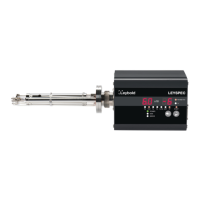300781172_002_C0 - 012/2019 - © Leybold 40
Cautions in operation
7. To avoid burns, take precautions including clear signs that read "Warning - High
Temperature" in a noticeable position near the analyzer tube.
8. Turn the heater on to start baking.
9. Upon completion of baking and after the analyzer tube has cooled down to
room temperature, install the sensor unit.
10.Confirm by measuring the water content (m/z=17, 18) and hydrocarbon type
gases (m/z=27, 29, 39, 41, 43, 55, 56, 57, and so forth) have decreased as
compared with before baking.
11.When the temperature and humidity of the controller changes, the resolution
changes and the position of the mass numbers also shift. Adjust the resolution and
mass number calibration while temperature and humidity are constant.
9.5 Calibration
For accurate measurement, it is necessary to calibrate mass number and sensitivity.
9.5.1 Mass number calibration
Mass numbers are calibrated before shipping, but can change in your measurement
environment. Mass numbers also shift if the analyzer tube is contaminated.
For the relationship between mass numbers and ions, refer to Appendix "Peaks of
Major Residual Gases".
In the dedicated gas analysis software, use the analogue mode recipe to perform
mass number calibration. Refer to the software instructions for further details.
WARNING:
Risk of burns. Beware of high temperatures.

